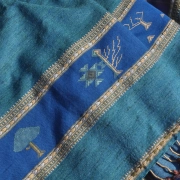Indian artisans are reeling from COVID-19 and its economic repercussions, and people are concerned that they face an existential crisis.
Once again, we face the fundamental question: who are artisans?
In India, artisans are most often perceived as skilled workers. In Kutch, however, traditional artisans conceptualized textiles, procured raw materials and created them. Moreover, artisans delivered their work to clientele, with whom they often had personal relationships.
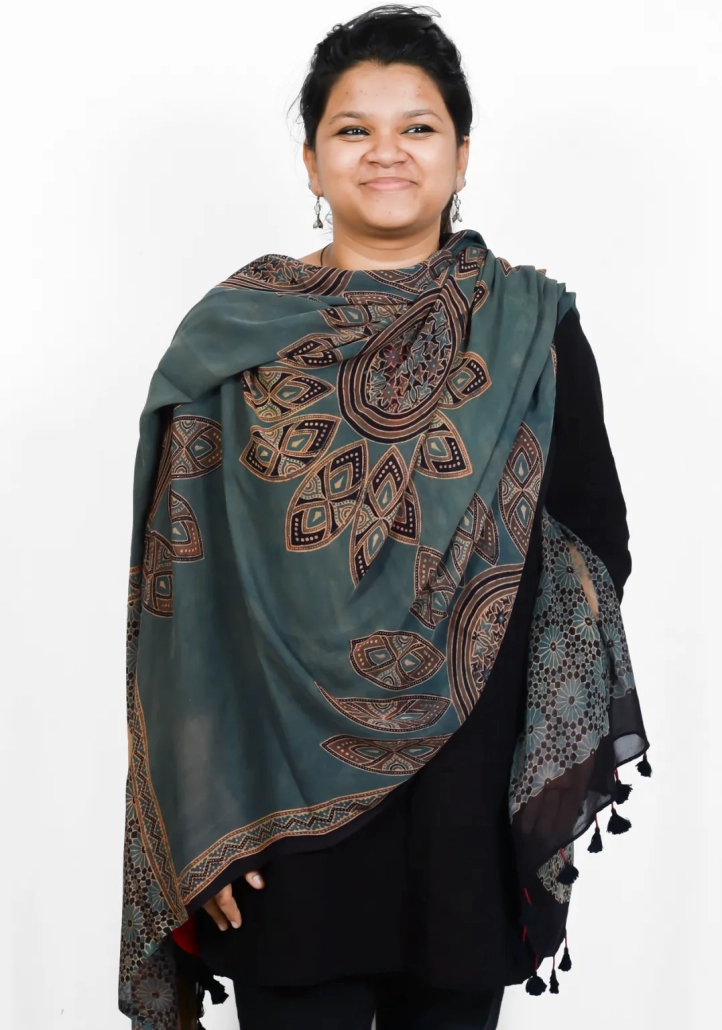
Khalid Usman Khatri created an Ajrakh hand-print and natural dyed stole for their Unity in Diversity collection.
The 1960s marked a drastic change for these artisans. India had focused on rapid industrialization as key to nation building. With inflation and the influx of cheaper industrial products, traditional clients began to prefer synthetics and mill-made fabrics to hand craft. Seeking alternatives, artisans looked to more distant, unknown markets. Additionally, industrialization introduced the concept of design as an entity, and in the process of separating concept and execution, artisans became “workers.”
Relegating artisans to worker status results in minimizing the value of their work, yields little opportunity for creativity or recognition, and in general lessens interest in craft, particularly among the next generation. Today, artisans leave craft because, from their perspective, it does not generate enough income nor enough respect for the effort that it requires.
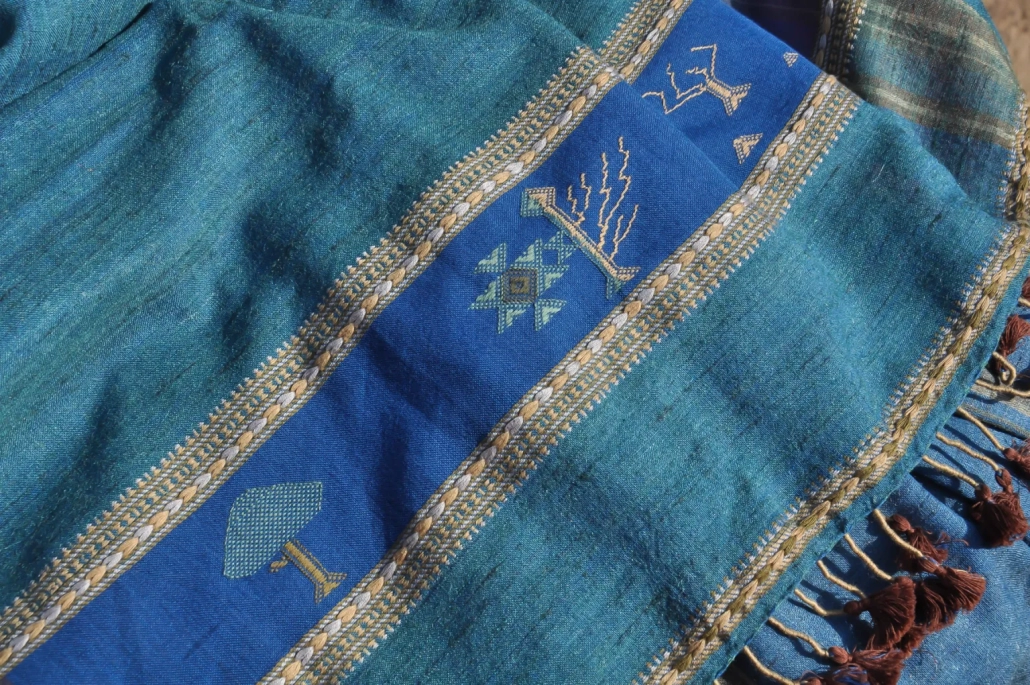
Detail of stole handwoven by Pachan Premji Siju depicting problems and solutions of global climate change.
After many years of studying craft traditions of Kutch and then many years working with hand embroiderers, I began a design education program for artisans. The concept was to value traditional craft as cultural heritage and provide what is understood as higher or specialized education directly to artisans. I believed that by learning to innovate within traditions and connecting with contemporary markets, artisans could utilize their strength and creativity to increase their capacity. Simultaneously, when artisans determine the evolution of their cultural heritage, traditions are genuinely sustained.
I received an Ashoka Fellowship to develop the program and launched it in 2005 as Kala Raksha Vidhyalaya. Eight years later, to build it into an institute, I joined forces with the K.J. Somaiya Gujarat Trust to begin Somaiya Kala Vidya.
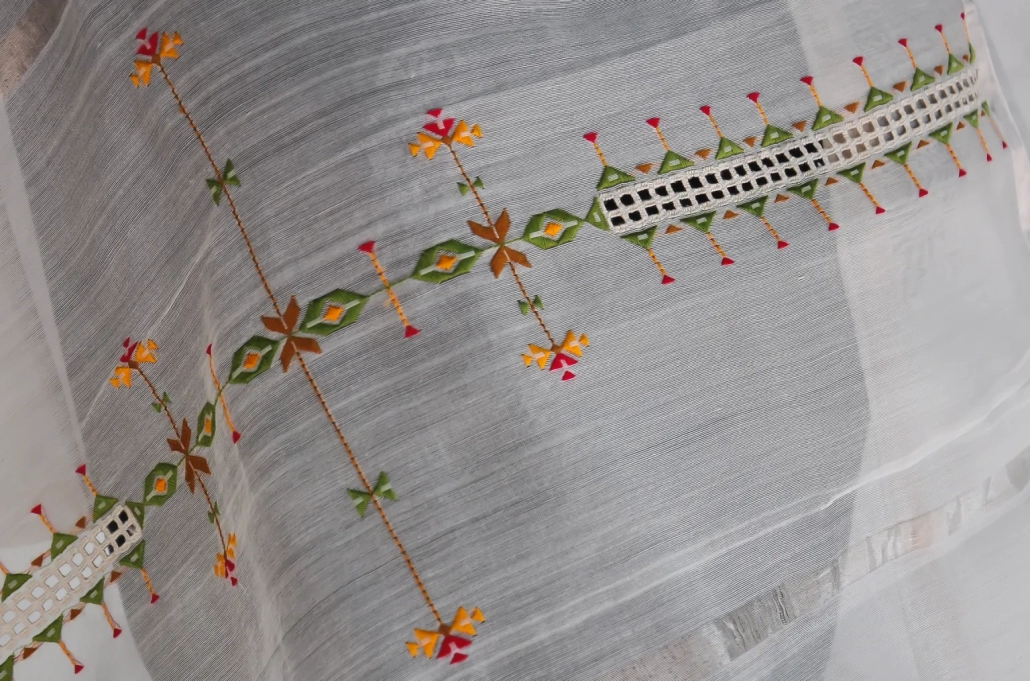
Tulsi Puroshottam Puvar created a hand embroidered stole using traditional drawn and bound detailing inspired by teaching chikan embroiderers in Lucknow.
The year-long course, modular and taught in local languages, enables artisans to participate. It re-imagines traditional systems in an appropriate contemporary form. It teaches artisans to appreciate their traditions and to recognize aspects that make them unique. Then it teaches them to innovate. They learn to look beyond technique to using technique in visual language and to find their own unique interpretations drawn from common traditions. Among 197 design graduates, there has been virtually no duplication in their work.
Almost fifteen years of design education have clearly demonstrated success. Graduates have reached new markets and increased their incomes. With individual expressions, traditions have diversified, and the market has expanded. As one small-scale artisan noted, “My income has increased ten times, while the long-time major producer’s income has not suffered. It is a win-win situation!” Graduates have won the Indian President’s and World Crafts Council awards. The works of three graduates were exhibited in the contemporary design section of the Victoria and Albert Museum’s major exhibition, “The Fabric of India.” In 2017, seven graduates were the first artisans to be recognized as designers on the national Lakme Fashion Week ramp. Thirteen design graduates and two advisors have participated in the International Folk Art Market| Santa Fe. Perhaps the most significant success is children of artisans in Kutch returning to craft as an excellent option rather than a last resort.
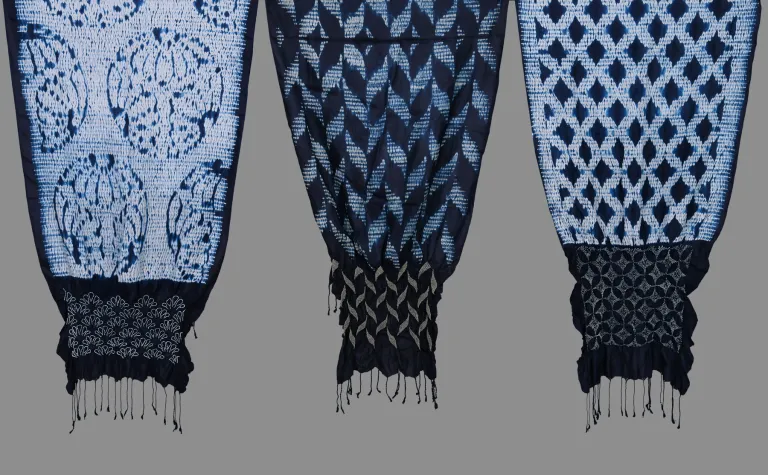
Bandhani and shibori resist dyed stoles created by Abdulaziz Alimamad Khatri inspired by a plant called “cobra hood,” a local grass, and lattice windows. Photo Credit: Ketan Harshad Pomal, L.M. Studio
Because commercialization of craft has followed an industrial model, the assumption is that craft must scale up to succeed. A key goal of our educational programs is to encourage individuality as an alternative path to success. And as the number of artisan design graduates in the circumscribed Kutch region grew, a new genre of artisan emerged: the Artisan Designer. These graduates differ from artisans and urban designers in that they both design and produce. Today, there is a community of Artisan Designers with new outlooks.
They define success as confidently knowing good design, having their own concepts and identity, knowing how to take feedback, and being able to talk to customers. “Success is having a voice,” they say. “It is using your creativity, decision-making power, achieving goals, and taking responsibility.”[i]
Education has enabled many Artisan Designers to creatively utilize the pause of the pandemic. Many weaver designers had limited raw materials, so they produced masterpieces using workmanship that would earn more value when markets reopened. Shakilbhai, a batik artist, used lockdown time to develop a line of natural dyed batiks, of which he had long dreamed. And many Artisan Designers took the opportunity to enhance online presentation skills.
Once travel is safe, I will be taking visitors to Kutch to meet many of these creative Artisan Designers and to introduce artisans to international taste. Until then, enjoy some examples of their innovations.
[i] Quoted from a meeting held with Bhujodi weaver design graduates. 20 February 2018.

